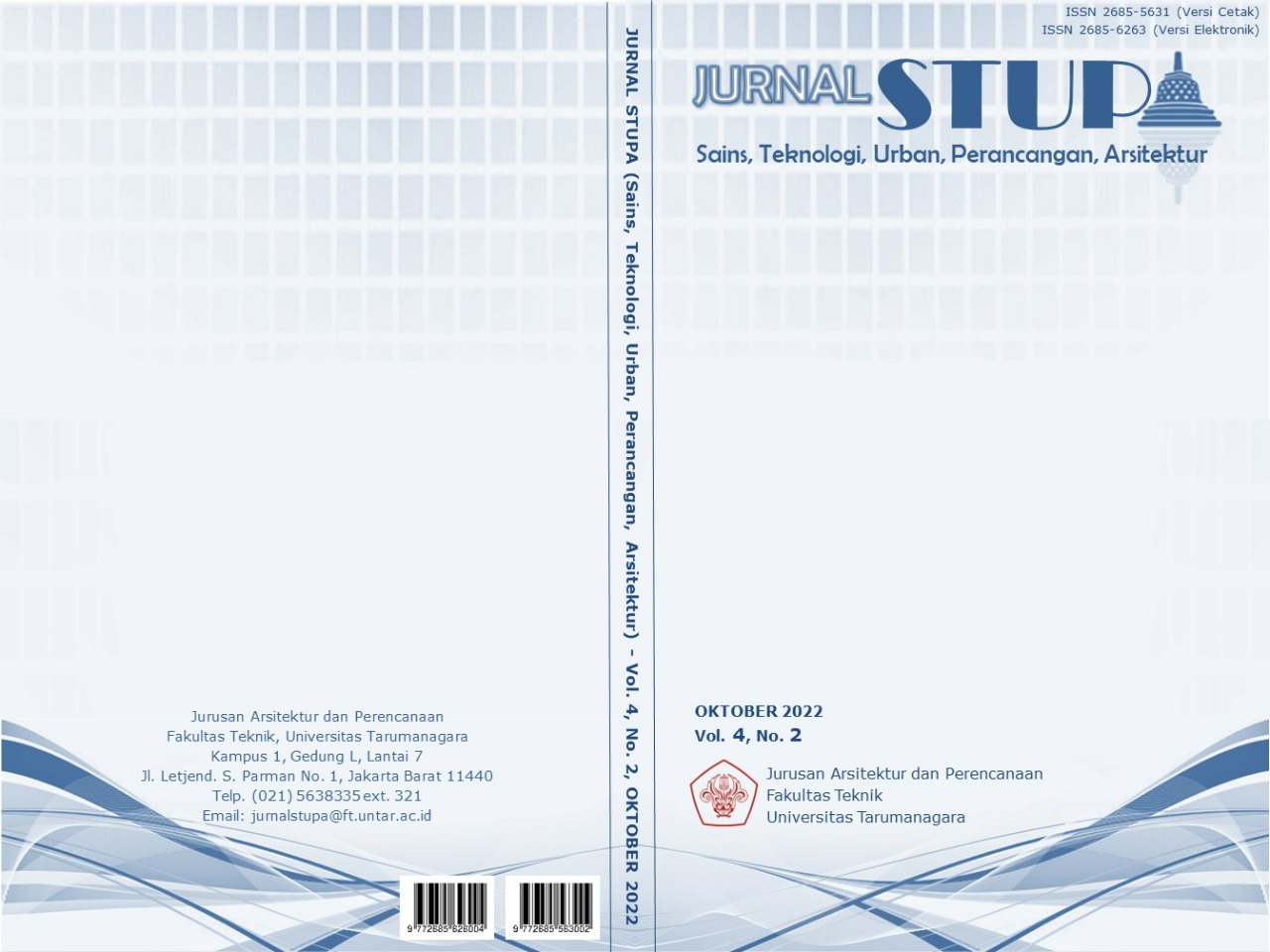PERANCANGAN GALERI EDUKASI DENGAN PENDEKATAN ARSITEKTUR SOSIAL DI KAWASAN PASAR KEMBANG, YOGYAKARTA
Main Article Content
Abstract
Every country in the world has many historical places including Indonesia. This historic place does not escape from events that reflect bad behavior that is difficult to tolerate, such as a place of prostitution. One of the famous areas is the Pasar Kembang or Sarkem which is located in the heart of Yogyakarta. The existence of Sarkem creates a bad public assessment of the lives of related people in the sex industry and the area where they live around. Based on this background, the authors take two problem formulations. How the development of the Red Light District Sarkem affects the community and the surrounding environment and how to change the negative image of Sarkem to be positive with the Urban Acupuncture approach in providing new facilities. The goal is to answer the problems that occur with the hypothesis of providing a new attractor with other positive activities. The literature review used in this journal is Urban Acupuncture, Configuration, Movement, Attractor (CMA) Theory, Public Space, Red Light District Area, and Educational Gallery. The research method used is the Activity, Interaction, User, Environment, Object (AIUEO) and Qualitative method. The results of this study are that the Red Light District Sarkem greatly affects people's views and reduces the quality of life of the surrounding community so the authors look for solutions by providing new attractors and adding facilities in the area such as the Museum of Love and Woman's Sexual Health which can improve the lives and quality of the surrounding community.
Keywords: Pasar Kembang Area; Prostitution; Social Architecture; Social Life; Urban Acupuncture
Abstrak
Setiap negara di dunia memiliki banyak tempat bersejarah termasuk negara Indonesia. Tempat bersejarah ini tidak luput dari adanya kejadian yang mencerminkan dari adanya perilaku buruk yang sulit untuk ditoleransi seperti adanya tempat prostitusi. Salah satu daerah yang terkenal adalah Pasar Kembang atau Sarkem yang letaknya di jantung kota Yogyakarta. Adanya tempat prostitusi di Sarkem menimbulkan penilaian masyarakat yang buruk terhadap kehidupan orang-orang terkait di industri seks dan wilayah tempat tinggal di sekitar Sarkem. Berdasarkan latar belakang ini, penulis mengambil dua rumusan masalah yaitu bagaimana perkembangan Red Light District Sarkem mempengaruhi masyarakat dan lingkungan sekitar dan bagaimana mengubah citra negatif Sarkem menjadi positif dengan pendekatan Urban Acupuncture dalam menyediakan fasilitas baru. Tujuannya untuk menjawab permasalahan yang terjadi dengan hipotesa menyediakan atraktor baru dengan kegiatan positif lainya. Kajian literatur yang digunakan dalam jurnal ini adalah Urban Acupuncture, Teori Configuration, Movement, Attractor (CMA), Ruang Publik, Kawasan Red Light Districts, dan Galeri Edukasi. Metode penelitian yang digunakan adalah Metode Activity, Interaction, User, Environment, Object (AIUEO) dan Kualitatif. Hasil dari penelitian ini adalah Red Light Districts Sarkem sangat mempengaruhi pandangan masyarakat dan menurunkan kualitas hidup masyarakat sekitar sehingga penulis mencari solusi dengan memberikan atraktor baru dan menambah fasilitas di kawasan Pasar Kembang seperti Museum of Love and Woman’s Sexual Health yang dapat meningkatkan kehidupan dan kualitas masyarakat sekitar.
Article Details

This work is licensed under a Creative Commons Attribution-NonCommercial-ShareAlike 4.0 International License.
This work is licensed under a Jurnal Sains, Teknologi, Urban, Perancangan, Arsitektur/ STUPA Creative Commons Attribution-NonCommercial-ShareAlike 4.0 International LicenseReferences
Amirin, Z. (2012). Produksi Wacana Seksualitas oleh Perempuan.
Badan Pusat Statistika. (2021). Kota Yogyakarta Dalam Angka 2021. BPS Kota Yogyakarta, 1–446. https://jogjakota.bps.go.id/publication/2021/02/26/4c85e0454525ceebd064473a/kota-yogyakarta-dalam-angka-2021.html
Carr, S., Francis, M., Rivlin, L. G., & Stone, A. M. (1993). Public space. Public Space, January 1991. https://doi.org/10.4324/9781315794808-4
Dewan Kehormatan Arsitek Ikatan Arsitek Indonesia, & Badan Keprofesian Ikatan Arsitek Indonesia. (2007). Kode Etik Arsitek dan Kaidah Tata Laku Profesi Arsitek Ikatan Arsitek Indonesia. 1–48. http://www.iai.or.id
Dinkes Kota Yogyakarta. (2020). Profil Kesehatan Kota Yogyakarta Tahun 2021. Jurnal Kajian Ilmu Administrasi Negara, 107, 107–126.
Hakim, R. (1987). Unsur Dalam Perancangan Arsitektur Landscape. Bina Aksara.
Haryadi & Setiawan, B. (1995). Arsitektur Lingkungan dan Perilaku. Jakarta: P3SL Dirjen Dikti, Depdikbud.
Lerner, J. (2014). Urban Acupuncture: Celebrating Pinpricks of Change that Enrich City Life. Journal of Urban Design, 21(4), 533–534. https://doi.org/10.1080/13574809.2016.1210286
Ningsih, C. (2004). Harga diri pekerja seks komersial pasar kembang yogyakarta.pdf.
Salmon, C. (2008). The World’s Oldest Profession. Oxford Scholarship Online: April 2010.
Sugiyono. (2010). Sugiyono Metode Penelitian Kuantitatif Kualitatif. Metode Penelitian Kuantitatif Kualitatif, 6.
Suratmin. (2000). Museum Sebagai Wahana Pendidikan Sejarah. MUSEUM Yogyakarta Masyarakat Sejarawan Indonesia Cabang Yogyakarta YOGYAKARTA.
Susanto, A. (2020). DALAM MENCARI KONDISI URBAN ACUPUNCTURE A = Attractor C = Configuration M = Movement.
Whyte, W. H. (1979). The Social Life of Small Urban Spaces (Conservation Foundation (ed.); illustrate, Vol. 15, Issue 2).



